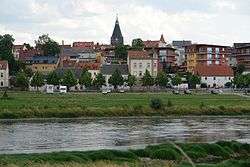Riesa
| Riesa | ||
|---|---|---|
 | ||
| ||
 Riesa | ||
Location of Riesa within Meißen district  | ||
| Coordinates: 51°18′29″N 13°17′38″E / 51.30806°N 13.29389°ECoordinates: 51°18′29″N 13°17′38″E / 51.30806°N 13.29389°E | ||
| Country | Germany | |
| State | Saxony | |
| District | Meißen | |
| Government | ||
| • Mayor | Gerti Töpfer (CDU) | |
| Area | ||
| • Total | 58.70 km2 (22.66 sq mi) | |
| Population (2015-12-31)[1] | ||
| • Total | 30,885 | |
| • Density | 530/km2 (1,400/sq mi) | |
| Time zone | CET/CEST (UTC+1/+2) | |
| Postal codes | 01587, 01589, 01591, 01594 | |
| Dialling codes | 03525 | |
| Vehicle registration | MEI, GRH, RG, RIE | |
| Website | www.riesa.de | |
Riesa (Upper Sorbian: Ryzawa) is a town in the district of Meißen in the Free State of Saxony, Germany. It is located on the Elbe River, approximately 40 kilometres (25 miles) northwest of Dresden.
History
The name Riesa is derived from Slavic Riezowe. This name, romanised as "Rezoa", appears first in October 1119 in a document from Pope Callixtus II.
The world's first 110 kV power line was installed between Riesa and Lauchhammer in 1912. Between 1952 and 1994, Riesa was the seat of a district.
During the 1980s, Riesa was the headquarters of the Group of Soviet Forces in Germany's 9th Tank Division.
Population history
The city grew from the start of the 20th century due to industrialisation. The population declined after German Reunification in 1989. The local steel works shut and the population fell from 52,000 to 32,000.
| Historical Population of Riesa | |||||||||
|---|---|---|---|---|---|---|---|---|---|
| Year | 1575 | 1834 | 1849 | 1875 | 1880 | 1900 | 1933 | 1939 | |
| Population | 350 | 1,631 | 2,679 | 5,707 | 6,259 | 13,491 | 26,248 | 29,963 | |
| Year | 1946 | 1950 | 1960 | 1981 | 1995 | 2000 | 2005 | 2010 | |
| Population | 34,406 | 36,150 | 36,769 | 51,857 | 42,429 | 39,367 | 36,221 | 34,013 | |
| Year | 2012 | 2013 | |||||||
| Population | 32,733 | 32,099 [2] | |||||||
Sights
Riesa has a 25m tall, 234 tonne, iron (GGG 40) sculpture of an oak trunk, named "Elbquelle", by Jörg Immendorff erected in 1999. There are many other names for the Elbquelle, for example "Rostige Eiche", which means "rusty oak". Many inhabitants of Riesa call the sculpture "Rostige Eiche", because it looks rusty.
In the city of Riesa there are two famous churches. The minster St. Marien arose in the year 1261 in addition to the Benedictine Abbey. The Trinitatis Church was constructed later, completion in the year 1897.

Riesa is also known locally for the Erdgas Arena, a large hall which hosted the European Sumo Wrestling Championship in October 2003 and the World Sumo Wrestling Championship in October 2004.
Culture
Riesa is well known locally for its pasta, which is produced in the Teigwaren Fabrik Riesa . Another symbol of Riesa are the "Riesaer Zündhölzer", the matches which were traditionally manufactured there.
Very famous is also the steel production in Riesa.
Notable people from Riesa include the former footballer Ulf Kirsten. Riesa has a football club, BSG Stahl Riesa. The club's crest is blue and white, as are the club colours. They play now in the Landesliga Sachsen (6th. League).
Twin towns
 Mannheim, Germany[4]
Mannheim, Germany[4] Sandy, Utah[5]
Sandy, Utah[5] Rotherham, Great Britain
Rotherham, Great Britain Lonato del Garda, Italy
Lonato del Garda, Italy Suzhou, China
Suzhou, China Villerupt, France
Villerupt, France Głogów, Poland
Głogów, Poland
References
- ↑ "Aktuelle Einwohnerzahlen nach Gemeinden 2015] (Einwohnerzahlen auf Grundlage des Zensus 2011)" (PDF). Statistisches Landesamt des Freistaates Sachsen (in German). July 2016.
- ↑ http://www.riesa.de/deu/verwaltung/statistik/media_statistik/2-2013.pdf
- ↑ "Twin cities". Riesa und die Welt e.V. Retrieved 2015-01-03.
- ↑ "Partner und Freundesstädte". Stadt Mannheim (in German). Retrieved 2013-07-26.
- ↑ "Sandy City Sister Cities Committee". Retrieved 2014-11-15.
External links
- Riesa tourism site
- Official Web site
- Official Web site of Stahl Riesa Footballclub
 Texts on Wikisource:
Texts on Wikisource:
- "Riesa". Encyclopædia Britannica (11th ed.). 1911.
- "Riesa". New International Encyclopedia. 1905.
